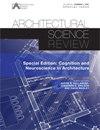A comparative study on structural design alternatives for twisted tall buildings with outriggers
IF 1.8
3区 艺术学
0 ARCHITECTURE
引用次数: 0
Abstract
Tall buildings are seen as iconic landmarks because of their bold effect on the city silhouette. To control this bold effect in an aesthetically desired manner, designers search for intriguing forms such as twisted buildings. There are two main approaches for designing the structural system of a twisted tall building. In the first approach, the twisted form of the building is obtained only by the rotation of the floors, and the structural system is maintained in a conventional, perpendicular way. Alternatively, the structural system and the floors of the building twist together. This study designates these as non-adaptive and adaptive, respectively. With different heights and angles of twist, non-adaptive and adaptive tall building models are created and analysed under the combined effect of wind and gravity loads. The dynamic properties, drift, moment, and torsion demands are compared to scrutinize and assess the potentials and limitations of these alternative approaches.带外伸支架的扭曲高层建筑结构设计方案的比较研究
高层建筑因其对城市轮廓的大胆影响而被视为标志性地标。为了以美观的方式控制这种大胆的效果,设计师们寻找有趣的形式,比如扭曲的建筑。扭曲高层建筑结构体系的设计主要有两种方法。在第一种方法中,建筑物的扭曲形式仅通过楼层的旋转获得,并且结构系统以传统的垂直方式保持。或者,结构系统和建筑的楼板会扭曲在一起。本研究将其分别指定为非适应性和适应性。在风荷载和重力荷载的共同作用下,建立并分析了不同高度和扭曲角度的非自适应和自适应高层建筑模型。将动态特性、漂移、力矩和扭转需求进行比较,以仔细检查和评估这些替代方法的潜力和局限性。
本文章由计算机程序翻译,如有差异,请以英文原文为准。
求助全文
约1分钟内获得全文
求助全文
来源期刊

Architectural Science Review
ARCHITECTURE-
CiteScore
4.80
自引率
8.70%
发文量
34
期刊介绍:
Founded at the University of Sydney in 1958 by Professor Henry Cowan to promote continued professional development, Architectural Science Review presents a balanced collection of papers on a wide range of topics. From its first issue over 50 years ago the journal documents the profession’s interest in environmental issues, covering topics such as thermal comfort, lighting, and sustainable architecture, contributing to this extensive field of knowledge by seeking papers from a broad geographical area. The journal is supported by an international editorial advisory board of the leading international academics and its reputation has increased globally with individual and institutional subscribers and contributors from around the world. As a result, Architectural Science Review continues to be recognised as not only one of the first, but the leading journal devoted to architectural science, technology and the built environment. Architectural Science Review publishes original research papers, shorter research notes, and abstracts of PhD dissertations and theses in all areas of architectural science including: -building science and technology -environmental sustainability -structures and materials -audio and acoustics -illumination -thermal systems -building physics -building services -building climatology -building economics -ergonomics -history and theory of architectural science -the social sciences of architecture
 求助内容:
求助内容: 应助结果提醒方式:
应助结果提醒方式:


